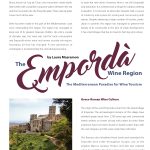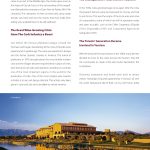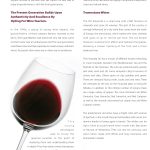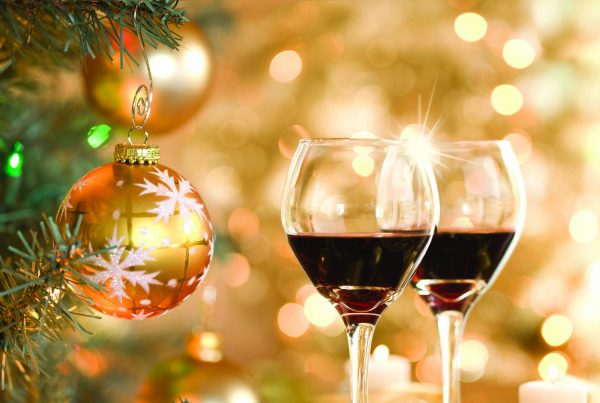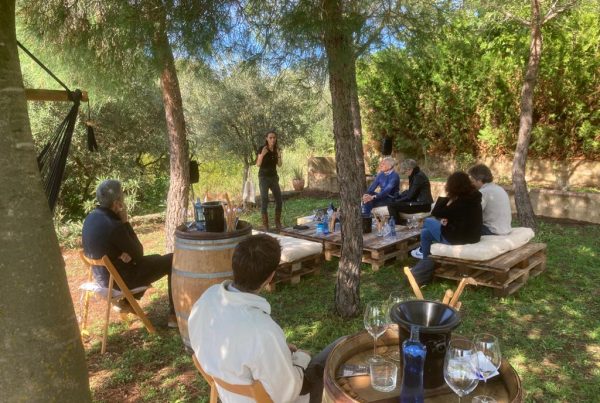THE MEDITERRANEAN PARADISE FOR WINE TOURISM
In the far northeastern tip of Spain, bordering with the south of France, there is a natural area formed by the end of the Pyrenees as they disappear into the Mediterranean Sea. At this point of the northern Costa Brava, known as Cap de Creus, the mountains create idyllic little creeks with crystalline, turquoise waters. Between the sea and the mountains lies the Empordà plain. Three natural parks cover much of the area.
Wine has been made in this part of the Mediterranean coast since winemaking first began. The region has managed to keep one of its greatest treasures hidden. Up until a couple of decades ago, the wine was sold for local consumption and Empordà wines were not known outside the region. Nowadays all that has changed. A new generation of oenologists is revolutionizing the vinicultural panorama.
The Empordà is an emerging region for both its wines and its wine tourism. Every year, there is a rise in the number of new vines planted and old vines recovered, in the number of new wineries and the number of tourists visiting the area that want to taste the new wines. However, wine is not the Empordà’s only attraction. It is a dream land, a refuge for Catalans seeking inspiration. It is the land of artists like Salvador Dalí, a source of creativity and a place for resting and communing with nature. Despite attracting a large number of tourists, partic- ularly in summer, this region has managed to preserve the beauty of its countryside in the face of urban development. It has small villages that live on tourism, farming and culture.
Greco-Roman Wine Culture
The origin of the word Empordà comes from the Greek village of Empúries. The archaeological remains of this village have revealed grape seeds from 2,700 years ago and commercial letters written on sheets of lead with orders for wine. Wine amphoras have even been found on board sunken ships with the cork stoppers and the wine inside them still intact.
The Romans also inhabited these lands and extended the Empordà wine trade throughout Europe, just as the emperor Marcus Aurelius Probus (232-282 AD) ordered when he said: “May the citizens plant vines and become rich.” Vine growing has always been synonymous with prosperity, culture and wealth.
Monasteries, Vine Terraces and Stone Wine Cellars
The Greeks and Romans left an indelible mark but their age came to an end. In the Middle Ages, the monks grew vines on the slopes of Cap de Creus, in the surroundings of the magnif- icent Benedictine monastery of Sant Pere de Rodes (9th-19th centuries). The cultivation of vines on these arid, stony, steep terrains was hard work but the money that they made from selling wine enabled them to be self-sufficient.
The Great Wine-Growing Crisis Gave The Cork Industry a Boost
Just before the famous phylloxera plague crossed the Pyrenees and began devastating all the vines, Empordà wine experienced its golden age. The wine was exported to Europe and the former Spanish colonies in America. The arrival of phylloxera, in 1879, brought about the most terrible modern crisis and the villages became impoverished. In place of vines, olive trees and cork oaks were planted. Costa Brava is currently one of the most important regions in the world for the production of corks. One of the most original wine tourism activities is to see cork being collected. This activity only takes place in June and July and is available at certain wineries.
THE CONTEMPORARY HISTORY OF EMPORDÀ WINE
The Grandparents Preserved the Tradition
In the 1930s, wine-growing began once again. After the crisis, the peasant farmers were hard-pressed for money and had to join forces. This was the origin of the local wine and olive oil cooperatives, some of which are still in operation today and open to public, such as the Celler Cooperatiu d’Espolla (1931), Empordàlia (1947) and Cooperativa Agrícola de Garriguella (1963).
The Parents’ Generation Became Involved In Tourism
With the arrival of the tourist boom in the 1960s, many farmers decided to move to the coast and go into tourism. They left the countryside to create a first-rate tourist destination, the Costa Brava.
Charming restaurants and hotels were built to attract visitors. Nowadays Empordà gastronomy is famous all over the world. Restaurants like El Bulli, run by chef Ferran Adrià, revolutionised modern cuisine for over two decades. Another reference in the area is El Celler de Can Roca (designated “Best Restaurant in the World” in 2013 and 2015 by the British magazine Restaurant. In fact, the province of Girona boasts the highest number of Michelin stars per capita. The best way to enjoy Empordà wines is with the local gastronomy.
The Present Generation Builds Upon Authenticity And Excellence By Opting For Wine Tourism
In the 1990s, a group of young wine experts, the grandchildren of those peasant farmers, returned to the farms. Their grandfathers had preserved very old vines, some of which were over a hundred years old. The new generations used these vines and their expertise to create unique, authentic wines. At present their wines are on their way to excellence.
The young oenologists seek to revive the regional varieties to the point of mastering them and understanding them in depth. Thus they obtain wines that express the terroir of the Empordà. They are modern wines but at the same time they speak to us of those 2,700 years of history. Some wineries opt for classic fermentations in stainless-steel vats with aging in 225-litre and 300-litre oak casks and finish by leaving the wine to rest in bottles with natural corks. Other wineries experiment with methods of fermentation and aging in amphoras, biodynamic crops and natural wines.
Tramuntana Wines
The DO Empordà is a small area with 2,000 hectares of vineyards and some 50 wineries. This part of the country is strongly influenced by a dry wind that comes from the north of Europe, the tramuntana, which batters the vines violently with gusts of up to 120 km per hour. The sea breeze however counteracts its effects and hydrates the grapes, allowing a slower ripening of the fruit and a more balanced vine.
The Empordà DO has a mosaic of different terrains stretching in small vineyards between the Mediterranean Sea and the foothills of the Pyrenees. The soils are predominantly granite and slate, sand and silt. Some vineyards cling to terraces of schists and slate. Others grow on clay, pebbles and gravel. There are vineyards facing north, south, east and west. There are vineyards by the sea, on the Empordà plain or lining the hillsides. In addition to this infinite number of terrains there are a large variety of grapes. The most dominant are White Grenache, Grey Grenache, Red Grenache, and Red Carignan, as well as the recently discovered but clearly very old White Carignan variety.
The predominant red wines have a bright color with aromas of ripe fruit; in the mouth they are full-bodied, with round, rich tannins thanks to being aged in barrels. The whites can be light, fresh and perfumed when made with Macabeo or Muscat of Alexandria. They can also be unctuous and warm when made with White and Grey Grenache and fermented in barrels.
Garnatxa de l’Empordà, An Uncut Diamond
One of the jewels of Mediterranean culture, which has so far been preserved, is the traditional Garnatxa de l’Empordà, a natural sweet wine aged by the solera system (that is, in barrels that are never completely emptied, in which successive grape vintages are blended). These wines are exposed to years of oxidative aging, yet still retain the acidity and sweetness of the grape. They are exquisite wines, with highly concentrated aromas of candied fruits like vine peaches and dried apricots, nuts like almonds and walnuts, roasted aromas like coffee and reductive aromas like honey. In the area there are wine cellars with very old aging barrels, with the oldest ones dating back to 1860.
FUN FACTS:
• A tour of Costa Brava may include a visit to the Greek and Roman ruins of Empúries, an archaeological site more than 2,000 years old, with remains of trade.
• The old 17th-century wine cellar at the monastery of Sant Pere de Rodes can still be visited today.
• Twenty-seven of these wineries make up the DO Empordà Wine Route and, together with other companies, offer different wine tourism experiences. www.rutadelvidoemporda.org
• The Empordà DO regulatory council was officially recognized in 1975. www.doemporda.cat
- Wine Journal cover page
- The Empordà Wine Region 1
- The Empordà Wine Region 2
- The Empordà Wine Region 3
- The Empordà Wine Region 4

About The Author
Laura Masramon is the Empordà Personal Sommelier and member of the DO Empordà Wine Route. She is also co-director of some wine branding seminars.


